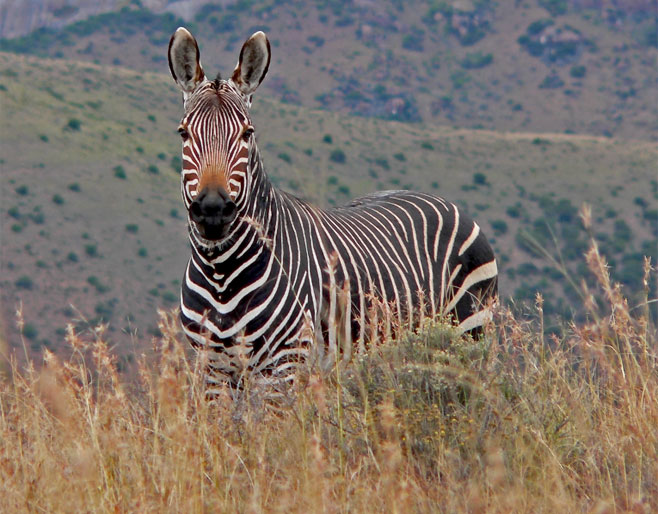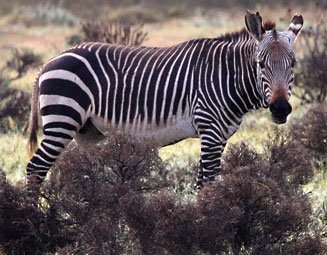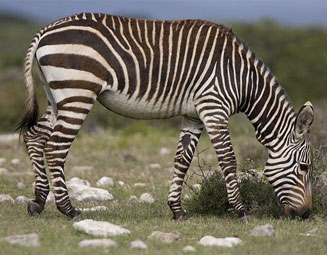|
Equus zebra zebra (Cape
mountain zebra)
Kaapse bergsebra; Kaapse bergkwagga; bergkwagga [Afrikaans];
Kapbergzebra [German]; zèbre de montagne [French]; idauwa [isiXhosa]; daou [Khoikhoi];
dou [San]
Life
>
Eukaryotes >
Opisthokonta >
Metazoa (animals) > Bilateria > Deuterostomia >
Chordata > Craniata > Vertebrata (vertebrates) >
Gnathostomata (jawed vertebrates) > Teleostomi (teleost
fish) > Osteichthyes (bony fish) > Class:
Sarcopterygii (lobe-finned fish) > Stegocephalia
(terrestrial vertebrates) > Reptiliomorpha > Amniota >
Synapsida (mammal-like reptiles) > Therapsida > Theriodontia
> Cynodontia > Mammalia (mammals)
> Placentalia (placental mammals) >
Laurasiatheria > Ferungulata > Paraxonia > Perissodactyla (odd-toed
ungulates) > Family: Equidae (horses, zebras, donkeys)
 |
|
Cape mountain zebra, Mountain Zebra National Park,
South Africa. [photo Francois Dreyer
©] |
 |
 |
|
Cape
mountain zebra, De Hoop Nature Reserve. [photo
Duncan Robertson ©] |
Cape mountain zebra, De Hoop Nature Reserve, South
Africa. [photo Trevor Hardaker ©] |
This subspecies of Mountain zebra is currently
limited in distribution to a few national parks and reserves in the
Western Cape and Eastern Cape provinces of South Africa. It very
nearly went extinct but was saved through the creation of the
Mountain Zebra National Park. It inhabits mountainous areas with
grass, up to an elevation of about 2000 m.
Identification
Although they resemble each other there are
some differences between the two mountain zebra subspecies, the Cape
mountain zebra and Hartmann’s
mountain zebra. Typically horse-like in appearance the Cape
Mountain zebra is smaller than both the
Plains zebra and the Hartmann’s Mountain zebra. The ground
colour of the sleek coat is white with black stripes. The black
stripes on the body are narrower than those on the rump and do not
continue onto the belly, stopping abruptly on the lower side of the
flanks. The underside is white. There is no shadow striping on the
body. Diagnostic of the species is the grid-iron type pattern over
the top of the tail formed by a series of transverse stripes. There
is a narrow black stripe that runs along the mid line of the tail to
the dark brown of black whisk. The stripes on the head are the
narrowest. An erect mane runs along the top of the neck from ears to
above the shoulders. The muzzle is black with russet-brown hair up
the face over the nose area. The ears of the Cape Mountain Zebra are
larger than those of the other zebra species. The hooves are narrow
and compact in shape with very hard ventral surface, this is an
adaptation to the hard and rocky terrain. A dewlap is present under
the throat, and is a diagnostic characteristic of the species.
Several theories have been proposed to try to
explain the conspicuous black and white striping characteristic of
the zebra coat. Earlier suggestions that the colouration functions
as camouflage, confuses predators or deters flies have been
discredited. Research suggests that the patterning may have a social
function, as zebras appear to respond to its visual stimulation. It
is thought that it stimulates mutual grooming in the preferred body
areas, this will in turn facilitate bonding within groups.
Size
Shoulder height 1.3 m; weight 250-260 kg.
Dental Formula
I C C P P M M = =

Distribution and habitat
The Cape Mountain zebra is endemic to the
Western Cape and Eastern Cape, and confined to mountainous areas up
to 2000 m, that provide suitable grasses for grazing and sufficient
drinking water. Historically they were distributed in the Cape
mountains south of the Orange River, but they are now limited to a
few nature reserves.
Behaviour
Cape Mountain zebra are non-territorial and
gregarious, living in breeding herds that consist of a breeding
stallion with 3-4 mares and their foals. Bachelor herds have a clear
social hierarchy and may be joined by non-breeding fillies for brief
periods. These zebra are diurnal with their most active periods
being after dawn, later in the morning and then late afternoon. When
threatened the dominant mare in the herd will lead the others away
to safety, the stallion remains at the rear to defend the herd if
necessary. Vocalizations include a high-pitched alarm call from the
stallion and a protracted squeal by a bachelor stallion when
challenged by the herd stallion.
Food
They are primarily grazers but will browse when
the quality of the grass supply declines.
Reproduction
The gestation period is about 360 days - i.e.
close on a year. Foals are born throughout the year, but foaling
peaks in summer during the period of new vegetation growth. A single
foal is born and is able to keep up with the herd within an hour of
birth. It stays in close association with its mother for the first
weeks of its life. Mares with new-born foals are aggressive towards
other members in the herd and actively discourage contact between
the foal and others. The foal remains with its mother until after
the next sibling is born and then leaves the maternal herd. Fillies
(young females) leave after about 19 months and colts (young males)
after 2 years, they then join up with the bachelor herds. Fillies
remain associated with a non-breeding bachelor herd for about 9
months and then join a breeding group herd, while colts remain with
the bachelor group for an average of 2.5 years.
Life span
26 years (captivity).
Conservation
The dramatic colouration of zebra coats makes
the skins desirable to hunters and they compete with domestic stock
for grazing in certain areas. In the early 1930’s it became clear
that the Cape Mountain zebra would become extinct unless it was
given special conservation. A small herd was established in the
Craddock district in 1937. The first herd was not successful but
some more animals were added from an adjoining farm and over the
years more land was acquired as part of the Mountain Zebra National
Park. By 1980 the population stood at 220 animals and has remained
fairly stable since. Each year up to 40 animals are transferred to
re-establish breeding herds in other sites within their original
distribution range.
There is very little evidence of hybridization
between the two subspecies of mountain zebra but this is regarded as
a major genetic threat and all possible actions should be taken to
prevent it in the future.
The Mountain zebra (both subspecies) is
classified as Vulnerable in the IUCN Red List of Threatened Species
(see link below). The continued existence of Cape mountain zebras is
dependent on the survival of populations protected within national
parks and reserves.
Links
Text by Denise Hamerton |
